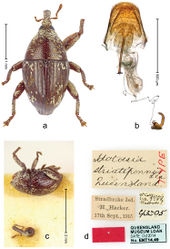Trigonopterus striatipennis
| Notice: | This page is derived from the original publication listed below, whose author(s) should always be credited. Further contributors may edit and improve the content of this page and, consequently, need to be credited as well (see page history). Any assessment of factual correctness requires a careful review of the original article as well as of subsequent contributions.
If you are uncertain whether your planned contribution is correct or not, we suggest that you use the associated discussion page instead of editing the page directly. This page should be cited as follows (rationale):
Citation formats to copy and paste
BibTeX: @article{Riedel2016ZooKeys, RIS/ Endnote: TY - JOUR Wikipedia/ Citizendium: <ref name="Riedel2016ZooKeys">{{Citation See also the citation download page at the journal. |
Ordo: Coleoptera
Familia: Curculionidae
Genus: Trigonopterus
Name
Trigonopterus striatipennis (Lea) comb. n. – Wikispecies link – Pensoft Profile
- Idotasia striatipennis Lea, 1928: 155.
Diagnostic description
Holotype (Fig. 30a). Length 2.43 mm. Color ferruginous; integument partly covered with brown or white scales, largely abraded. Body subovate; with weak constriction between pronotum and elytron; in profile evenly convex. Rostrum in apical half with submedian rows of punctures, sparsely covered with white scales. Eyes large, in subdorsal position. Forehead punctate, covered with brown scales. Pronotum coarsely punctate, covered with scales inserting at punctures, interspaces polished; disk clothed with brown scales, laterally and subapically with white scales. Elytra with striae deeply incised, narrow; intervals flat, each with two rows of scales largely covering surface, sutural interval with only one row; abraded scales leaving small punctures at point of insertion; subbasally and subapically clothed with white scales, remainder with brown scales and sparse white scales. Legs. Left foreleg broken off and missing; largely covered with white scales except subglabrous posterior face of meso- and metafemur and where abraded. Profemur with anteroventral ridge basally abruptly ending forming blunt angle; with subovate, slightly concave subbasal callus. Tibial apex with uncus, without premucro. Abdominal ventrites 1-2 medially flat. Terminalia (Fig. 30b). Male (ARC3663, Fig. 30e). Male rostrum with median ridge and pair of submedian ridges; covered with white scales. Abdominal ventrites 1-2 laterally swollen, medially concave. Penis (Fig. 30f) with sides of body slightly diverging to widened, rounded apex; transfer apparatus simple, spiniform, supported by single Y-shaped sclerite; ductus ejaculatorius without bulbus. Intraspecific variation. Length 2.32–2.53 mm. One specimen (ARC3666) with conspicuous pair of protrusions behind eyes, apparently a rare aberration.
Material examined
Type specimens. Female, holotype by monotypy (QMBA): Queensland, Stradbroke Island, coll. H. Hacker, 17-IX-1915 (labels Fig. 30d), ARC4034 (PCR failed). Other specimens (ANIC, QMBA, SMNK): Queensland: 5 exx, ARC3663 (EMBL # LN888167), ARC3665 (EMBL # LN888168), ARC3666 (EMBL # LN888169), North Stradbroke Isl., 3,5 km SW Point Lookout, Fishermans Road, 105 m, S27°26.507', E153°30.353', 24-III-2014, beaten from forest understorey; 8 exx, North Stradbroke Isl., track to Blue Lake, on Pteridium, 11-IX-1984; 7 exx, North Stradbroke Isl., track to Blue Lake, on Pteridium, 02-IX-1983; 3 exx, N Stradbroke Isl. Enterprise, S27°33', E153°28', Blackbutt #1, 90 m, 09-I-2002, sweeping 50934.
Distribution
Queensland: North Stradbroke Island.
Biology
Beaten from foliage of undergrowth in relatively dry forest.
Notes
Lea (1928)[1] stated in his description that the “type” was a “unique” specimen, and it therefore has to be regarded as the holotype. Regarding the distinction of this species from Trigonopterus squamosus (Lea), see the remarks above.
Taxon Treatment
- Riedel, A; Tänzler, R; 2016: Revision of the Australian species of the weevil genus Trigonopterus Fauvel ZooKeys, (556): 97-162. doi
Images
|
Other References
- ↑ Lea A (1928) Australian Curculionidae of the subfamilies Haplonycides and Cryptorhynchides. Transactions and Proceedings of the Royal Society of South Australia 52: 95–164.

